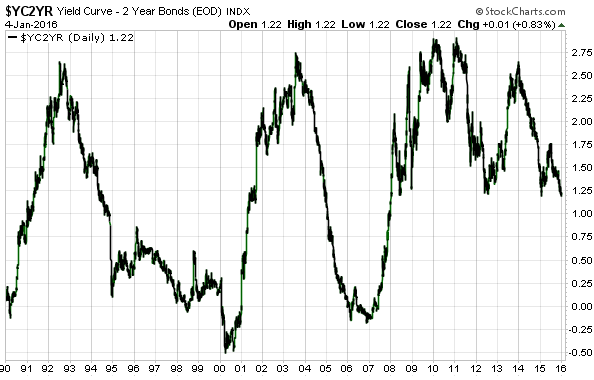-- Published: Tuesday, 5 January 2016 | Print | Disqus
I’ve seen articles explaining that rising interest rates are bearish for gold and I’ve seen articles explaining that rising interest rates are bullish for gold, so which is it? Are rising interest rates bullish or bearish for gold? The short answer is no — rising interest rates are neither bullish nor bearish for gold. Read on for the much longer answer.
I’ll begin by noting what happened to nominal interest rates during the long-term gold bull markets of the past 100 years. Interest rates generally trended downward during the gold bull market of the 1930s, upward during the gold bull market of the 1960s and 1970s, and downward during the gold bull market of 2001-2011. Therefore, history’s message is that the trend in the nominal interest rate does not determine gold’s long-term price trend.
History tells us that gold bull markets can unfold in parallel with rising or falling nominal interest rates, but this shouldn’t be interpreted as meaning that interest rates don’t affect whether gold is in a bullish or bearish trend. The nominal interest rate is not important, but the REAL interest rate definitely is. Specifically, low/falling real interest rates are bullish for gold and high/rising real interest rates are bearish. For example, when gold was making huge gains during the 1970s in parallel with high/rising nominal interest rates, real interest rates were generally low. This is because gains in inflation expectations were matching, or exceeding, gains in nominal interest rates (the real interest rate is the nominal interest rate minus the EXPECTED rate of currency depreciation). Also, the 2001-2011 bull market occurred in parallel with generally low real interest rates.
Very low real interest rates are artifacts of central banks. In the US, for example, the Fed’s actions ensured that the real short-term interest rate on “risk free” (meaning: no direct default risk) debt spent a lot of time in negative territory during the 1970s and during 2001-2011. In effect, “very low real interest rates” means “excessively loose monetary policy”.
Something else that affects gold’s price trend is the DIFFERENCE between long-term and short-term interest rates (the yield-spread, or yield curve), with a rising yield-spread (steepening yield curve) being bullish for gold and a falling yield-spread (flattening yield curve) being bearish. It works this way because a rising trend in long-term interest rates relative to short-term interest rates generally indicates either falling market liquidity (associated with increasing risk aversion and a flight to safety) or rising inflation expectations, both of which are bullish for gold.
As is the case with the real interest rate, under the current monetary system the yield-spread tends to be a symptom of what central banks are doing. If money were sound and free of central bank manipulation, then the yield-spread would spend most of its time near zero (the yield curve would be almost horizontal) and would experience only minor fluctuations, but thanks to the attempts by central banks to ‘stabilise’ the markets the yield-spread experiences huge swings. For example, the following chart shows the huge swings in the US 10yr-2yr yield-spread since 1990. The periodic up-swings in this chart were generally due to the Fed exerting irresistible downward pressure at the short end of the curve while the discounting by the market of currency depreciation risk caused interest rates at the long end to be ‘sticky’.

Last but not least, gold is influenced by the economy-wide trend in credit spreads (the differences between interest rates on high-quality and low-quality debt securities). Gold, a traditional haven in times of trouble, tends to do relatively well when credit spreads are widening and relatively poorly when credit spreads are contracting. This is because widening credit spreads typically indicate declining economic confidence.
If the three main interest-rate drivers (the real interest rate, the yield-spread and credit spreads) are gold-bullish then there’s a high probability that gold will be in a strong upward trend in terms of all currencies and most commodities. By the same token, if the three main interest-rate drivers are gold-bearish then there’s a high probability that gold will be in a strong downward trend in both nominal and real terms. However, it’s not uncommon for the interest-rate conditions to be mixed. The past year is a good example of a mixed interest-rate backdrop for gold in that during this period the credit-spread situation was generally gold-bullish (credit spreads were widening) while the real interest rate and yield-spread trends were generally gold-bearish. The net effect of this interest-rate backdrop was slightly bearish for gold.
In summary, gold benefits from low/falling real interest rates, an increasing yield-spread (a steepening yield curve), and widening credit spreads, each of which can occur when nominal interest rates are rising or falling. You can therefore ignore the “rising interest rates are bearish for gold” and the “rising interest rates are bullish for gold” arguments. The relationship between gold and interest rates is not that simple.
http://tsi-blog.com/
| Digg This Article
-- Published: Tuesday, 5 January 2016 | E-Mail | Print | Source: GoldSeek.com

